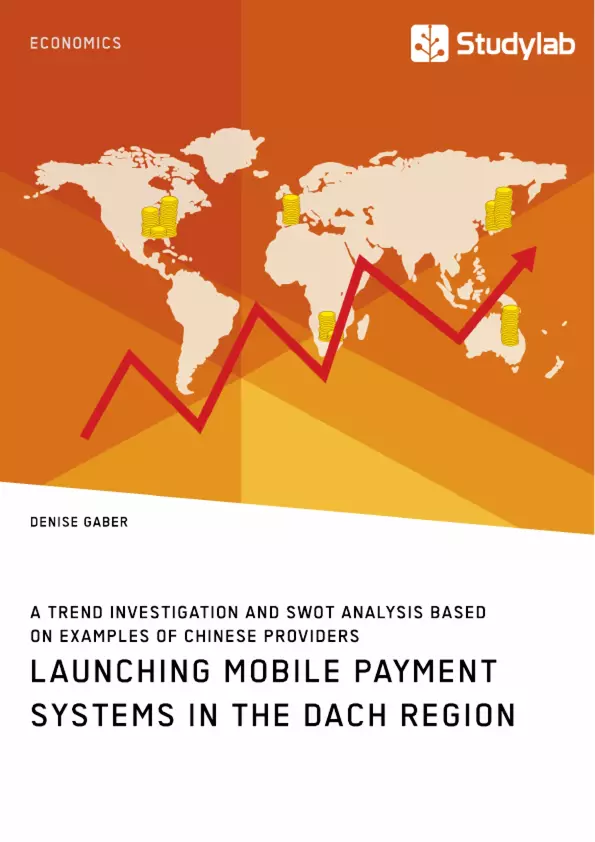Mobile business expands rapidly. The increasing number of Internet-enabled devices is creating an ecosystem with almost endless possibilities. In order to survive in this emerging ecosystem, companies have to implement new applications and take many actions and adaptions. In fact, this need for innovation affects nearly every online business.
Denise Gaber examines transactions in local shops made through payment applications on customers’ smartphones, the so-called Proximity Mobile Payment Systems. She also explains the trend of proximity mobile payment and its rapid development in China compared to the low adoption rate in Austria, Germany and Switzerland.
How can mobile payment be implemented successfully? Gaber gives a SWOT analysis to indicate obstacles and to plan implementation and business strategies. As best practices she examines companies like WeChat Wallet and Alipay. Her findings are based on a profound analysis of the markets of Germany, Austria, Switzerland and China.
In this book:
- app;
- e-commerce;
- m-commerce;
- mobile commerce;
- m-payment
Inhaltsverzeichnis (Table of Contents)
- Abstract
- Acknowledgements
- Introduction
- Mobile Payment Systems - An Overview
- The Chinese Mobile Payment Market
- Alipay - The Mobile Payment System of Ant Financial
- WeChat Wallet - The Mobile Payment System of Tencent
- The Mobile Payment Market in the DACH Region
- SWOT Analysis - The Development of Mobile Payment Systems in the DACH Region
- Conclusion
- References
Zielsetzung und Themenschwerpunkte (Objectives and Key Themes)
This paper aims to investigate the rapid development of proximity mobile payment systems in China, contrasting this with the relatively low adoption rate in Austria, Germany, and Switzerland (DACH). It seeks to understand the driving forces behind this divergence and provide a foundation for planning implementation strategies and business strategies in the DACH region, using a SWOT analysis framework.
- The rise of proximity mobile payments in China
- The challenges and opportunities for mobile payment systems in the DACH region
- Comparative analysis of the Chinese and DACH markets
- Implementation strategies for mobile payment systems in the DACH region
- The role of technology, regulations, and consumer behavior in driving mobile payment adoption
Zusammenfassung der Kapitel (Chapter Summaries)
- Introduction: This chapter introduces the topic of mobile payment systems and their significance in the evolving financial landscape. It highlights the rapid growth of mobile payments in China and the contrasting situation in the DACH region, setting the stage for the study's focus.
- Mobile Payment Systems - An Overview: This chapter provides a comprehensive overview of mobile payment systems, defining key concepts, outlining the various types of systems available, and exploring their advantages and challenges. It also delves into the technological infrastructure and regulatory frameworks surrounding mobile payments.
- The Chinese Mobile Payment Market: This chapter examines the rapid growth and dominant market position of mobile payments in China. It analyzes the key drivers behind this success, highlighting the role of technology, consumer behavior, government support, and the influence of major players like Alipay and WeChat Wallet.
- Alipay - The Mobile Payment System of Ant Financial: This chapter presents a detailed analysis of Alipay, one of China's dominant mobile payment platforms. It explores its features, functionalities, business model, and impact on the Chinese market.
- WeChat Wallet - The Mobile Payment System of Tencent: This chapter examines WeChat Wallet, another prominent mobile payment platform in China. It explores its functionalities, integration with WeChat's social messaging platform, business model, and competitive landscape within the Chinese market.
- The Mobile Payment Market in the DACH Region: This chapter shifts the focus to the DACH region, analyzing the current state of mobile payment adoption. It identifies key players, explores existing infrastructure, and investigates the reasons for slower adoption compared to China.
- SWOT Analysis - The Development of Mobile Payment Systems in the DACH Region: This chapter provides a comprehensive SWOT analysis of the potential for mobile payment systems in the DACH region. It identifies strengths, weaknesses, opportunities, and threats, offering valuable insights into the challenges and opportunities for future development.
Schlüsselwörter (Keywords)
The core focus of this study revolves around mobile payment systems, specifically their adoption, implementation, and market dynamics. Key terms include proximity payments, mobile payment systems (MPS), Alipay, WeChat Wallet, fintech, DACH region, China, comparison, trends, cashless, innovation, and SWOT analysis.
- Quote paper
- Denise Gaber (Author), 2020, Launching mobile payment systems in the DACH region. A trend investigation and SWOT analysis based on examples of Chinese providers, Munich, GRIN Verlag, https://www.grin.com/document/495807



